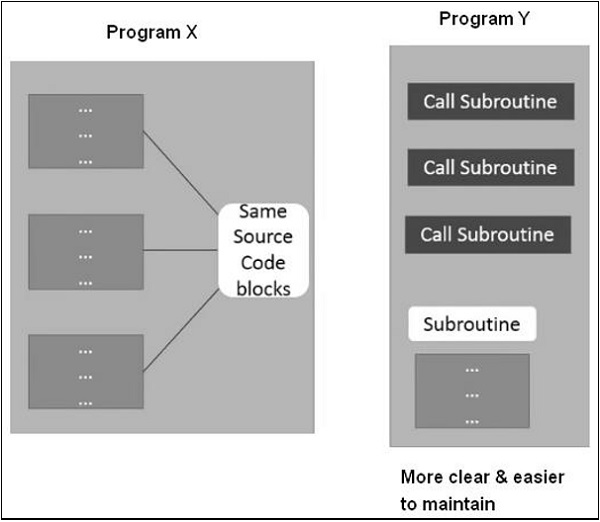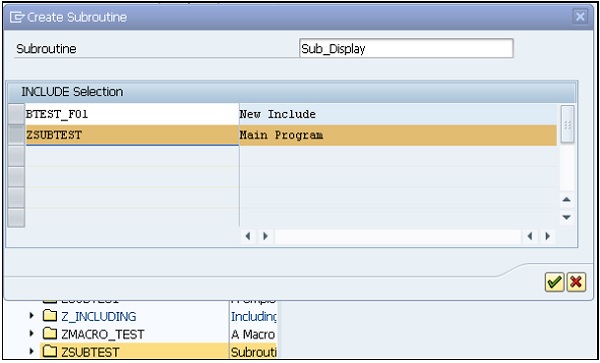
- SAP ABAP - Home
- SAP ABAP - Overview
- SAP ABAP - Environment
- SAP ABAP - Screen Navigation
- SAP ABAP - Basic Syntax
- SAP ABAP - Data Types
- SAP ABAP - Variables
- SAP ABAP - Constants & Literals
- SAP ABAP - Operators
- SAP ABAP - Loop Control
- SAP ABAP - Decisions
- SAP ABAP - Strings
- SAP ABAP - Date & Time
- SAP ABAP - Formatting Data
- SAP ABAP - Exception Handling
- SAP ABAP - Dictionary
- SAP ABAP - Domains
- SAP ABAP - Data Elements
- SAP ABAP - Tables
- SAP ABAP - Structures
- SAP ABAP - Views
- SAP ABAP - Search Help
- SAP ABAP - Lock Objects
- SAP ABAP - Modularization
- SAP ABAP - Subroutines
- SAP ABAP - Macros
- SAP ABAP - Function Modules
- SAP ABAP - Include Programs
- SAP ABAP - Open SQL Overview
- SAP ABAP - Native SQL Overview
- SAP ABAP - Internal Tables
- SAP ABAP - Creating Internal Tables
- ABAP - Populating Internal Tables
- SAP ABAP - Copying Internal Tables
- SAP ABAP - Reading Internal Tables
- SAP ABAP - Deleting Internal Tables
- SAP ABAP - Object Orientation
- SAP ABAP - Objects
- SAP ABAP - Classes
- SAP ABAP - Inheritance
- SAP ABAP - Polymorphism
- SAP ABAP - Encapsulation
- SAP ABAP - Interfaces
- SAP ABAP - Object Events
- SAP ABAP - Report Programming
- SAP ABAP - Dialog Programming
- SAP ABAP - Smart Forms
- SAP ABAP - SAPscripts
- SAP ABAP - Customer Exits
- SAP ABAP - User Exits
- SAP ABAP - Business Add-Ins
- SAP ABAP - Web Dynpro
SAP ABAP - Subroutines
A subroutine is a reusable section of code. It is a modularization unit within the program where a function is encapsulated in the form of source code. You page out a part of a program to a subroutine to get a better overview of the main program, and to use the corresponding sequence of statements many times as depicted in the following diagram.

We have program X with 3 different source code blocks. Each block has the same ABAP statements. Basically, they are the same code blocks. To make this code easier to maintain, we can encapsulate the code into a subroutine. We can call this subroutine in our programs as many times as we wish. A subroutine can be defined using Form and EndForm statements.
Following is the general syntax of a subroutine definition.
FORM <subroutine_name>. <statements> ENDFORM.
We can call a subroutine by using PERFORM statement. The control jumps to the first executable statement in the subroutine <subroutine_name>. When ENDFORM is encountered, control jumps back to the statement following the PERFORM statement.
Example
Step 1 − Go to transaction SE80. Open the existing program and then right-click on program. In this case, it is 'ZSUBTEST'.
Step 2 − Select Create and then select Subroutine. Write the subroutine name in the field and then click the continue button. The subroutine name is 'Sub_Display' as shown in the following screenshot.

Step 3 − Write the code in FORM and ENDFORM statement block. The subroutine has been created successfully.
We need to include PERFORM statement to call the subroutine. Lets take a look at the code −
REPORT ZSUBTEST. PERFORM Sub_Display. * Form Sub_Display * --> p1 text * <-- p2 text FORM Sub_Display. Write: 'This is Subroutine'. Write: / 'Subroutine created successfully'. ENDFORM. " Sub_Display
Step 4 − Save, activate and execute the program. The above code produces the following output −
Subroutine Test: This is Subroutine Subroutine created successfully
Hence, using subroutines makes your program more function-oriented. It splits the program's task into sub-functions, so that each subroutine is responsible for one subfunction. Your program becomes easier to maintain as changes to functions often only have to be implemented in the subroutine.